
CAE Software【Femtet】Murata Software Co., Ltd.

Example38 TDR Analysis with Transient Analysis
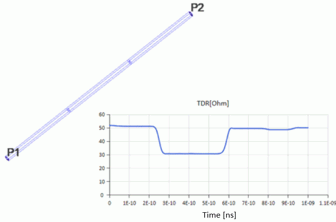
General
-
Impulse wave and stepped wave are used.
-
Unless specified in the list below, the default conditions will be applied.
-
Electromagnetic-transient analysis is available in an optional package.
Analysis Condition
|
Item |
Setting |
|
Solver |
Electromagnetic Analysis [Hertz] |
|
Analysis Space |
3D |
|
Analysis Type |
Transient Analysis Select Input at each port |
|
Unit |
mm |
|
Tab |
Setting Item |
Setting |
|
Mesh |
General Mesh Size |
0.5 [mm]*1 |
|
Frequency-Dependent Meshing |
|
|
|
Transient Analysis |
Input Waveform |
Impulse model
Step model *2
|
|
Finish Time of Calculation |
1.0×10-9 [s] |
*1 Small general mesh size is set because fine meshes are needed for the entire transmission line.
*2 To reproduce the stepped waveform in the Step model, the same time is set for the duration and the finish time of calculation.
Model
A coaxial cable is made of two insulators with different permittivity. For the outer boundary condition, electric wall is applied to the inside and outside of the cable.
Relative permittivity for MAT1 and MAT2 is set so as to give them the impedance of about 50[Ω] and 30[Ω] respectively.

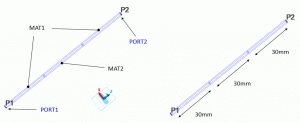
Body Attributes and Materials
|
Body Number/Type |
Body Attribute Name |
Material Name |
|
Body10/Solid |
MAT1 |
MAT1 |
|
Body11/Solid |
MAT1 |
MAT1 |
|
Body12/Solid |
MAT2 |
MAT2 |
|
Material Name |
Tab |
Properties |
|
MAT1 |
Permittivity |
Relative permittivity: 1.0 |
|
MAT2 |
Permittivity |
Relative permittivity: 2.8 |
Boundary Condition
|
Boundary Condition Name/Topology |
Tab |
Boundary Condition Type |
Setting |
|
PORT1/Face |
Electric |
Port |
Integral Path:
Reference Impedance: select
|
|
PORT2/Face |
Electric |
Port |
Integral Path:
Reference Impedance: select
|
|
Outer Boundary Condition |
Electric |
Electric Wall |
Results
The input/output voltage and TDR of the ports are confirmed in the result table of electromagnetic analysis (time domain).
Impulse model
The input voltage and the output voltage at PORT1 are as in the Fig. 1.

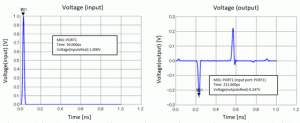
Fig. 1: The input and output voltage at PORT1
For the input of 1[V], the reflection is -0.247[V] at about 230[ps]. As the peak of the input wave is at 30[ps], it can be said that the input electromagnetic wave is
reflected at the border of MAT1 and MAT2 where the impedances are unmatched and returned over 200[ps].
These values can be estimated and verified in the following way.
- The traveling distance until coming back to PORT1 after reflected at the unmatched portion is 60mm. The propagation speed of the electromagnetic wave in MAT1 is 3.0 x 108[m/s].
Therefore the time until the reflected wave returns to PORT1 is 60mm/3.0×108[m/s] = 200[ps] - Characteristic impedance of PORT1 and coaxial cable MAT2 is about 50[Ω] and 30[Ω] respectively.
The reflectance is (30 – 50) / (30 + 50) = -0.25. Therefore, the reflection of the input of 1V will be -0.25V.
From TDR of the result table (Fig. 2), it is confirmed that the characteristic impedance of the coaxial cable MAT2 is 30[Ω].

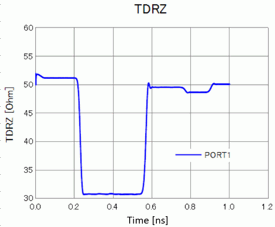
Fig. 2: TDR of PORT1 (Impulse model)
Step model
The similar result is obtained with the step model. The stepped wave rises more steeply than the impulse wave and TDR changes faster than the impulse model.
It can be confirmed as shown in Fig. 3.

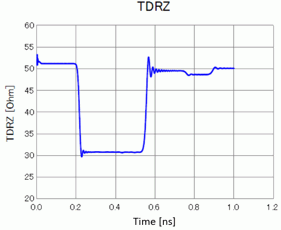
Fig. 3: TDR of PORT1 (Step model)

